Traditional Clothing of Iran: Exploring Iran's Rich Heritage
The traditional clothing of Iran holds immense significance in the country's rich and diverse culture.
With a history spanning thousands of years, Iranian attire represents a unique amalgamation of tradition, artistry, and regional diversity. Exploring the vibrant tapestry of traditional clothing in Iran provides a window into the country's rich heritage and the values cherished by its people.
Iran's traditional clothing showcases a remarkable diversity influenced by its historical and cultural background. Throughout history, various civilizations, such as the Persian Empire, Parthians, and Sassanids, have shaped the evolution of Iranian attire. The intricate tapestry of styles, fabrics, and designs found in traditional Iranian clothing reflects the complex layers of cultural influences that have shaped the nation.
From the opulent court garments of ancient Persian nobility to the humble attire of rural communities, each region of Iran exhibits its distinct clothing traditions. The diversity in traditional clothing is influenced by factors such as geography, climate, religion, and local customs. This has resulted in a wide array of traditional costumes that vary from region to region, providing a fascinating glimpse into Iran's cultural mosaic.
In this article, we are going to introduce you to Iran's national dress and Persian cultural clothes.
Historical Background of the National Costume of Iran

Traditional clothing in Iran has deep roots in the country's rich historical tapestry, which spans thousands of years. The evolution of Iranian attire can be traced back to the influence of ancient civilizations and the dynasties that have shaped the region's history.
Ancient Civilizations

Ancient civilizations such as the Elamites, Medes, and Achaemenids played a significant role in establishing the foundations of Iranian clothing. The Achaemenid Empire, under the rule of Cyrus the Great, introduced elaborate and luxurious clothing adorned with precious jewels, reflecting the opulence of the Persian nobility.
Subsequent dynasties, such as the Parthians and Sassanids, left an indelible mark on Iranian attire. The Parthians introduced garments like the tiara, a high conical hat, and long flowing robes. The Sassanian Empire further enriched traditional clothing with intricate patterns, vibrant colors, and sophisticated embroidery techniques.
After Islam
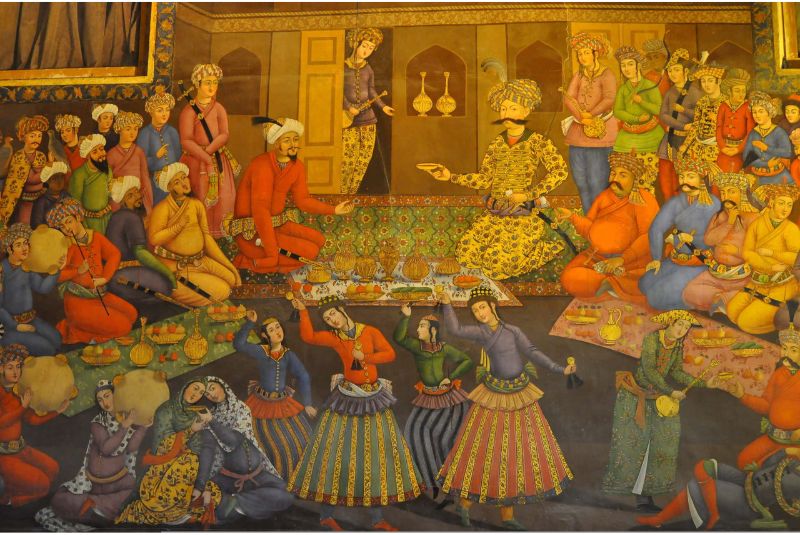
The advent of Islam in the 7th century brought a shift in Iranian clothing. Islamic influences, combined with pre-existing Persian traditions, resulted in the development of distinctive Islamic attire. Modesty became an essential aspect of clothing, particularly for women, leading to the emergence of garments like the chador, a loose-fitting cloak, and the hijab, a head covering.
Over time, Iranian traditional clothing has undergone various transformations due to the influences of foreign invasions, such as the Mongols and Timurids, and the later Safavid dynasty. The Safavids revived the Persian identity and contributed to the revival of traditional clothing, emphasizing elegance, refinement, and fine craftsmanship.
During the Qajar era, which lasted from the late 18th to the early 20th century, Iranian clothing witnessed further evolution. Traditional garments were adorned with intricate hand-woven patterns, delicate embroidery, and luxurious fabrics. Women wore colorful, flowing dresses, while men favored long coats and turbans.
Modern Times
In the modern era, Western influence has made its mark on Iranian clothing. The Pahlavi dynasty, which ruled from the early 20th century until 1979, introduced elements of Western fashion into Iranian society. However, the Iranian Revolution of 1979 brought about a resurgence of traditional clothing as a symbol of national pride and cultural identity.
The historical context of traditional clothing in Iran reveals a remarkable journey of cultural exchange, adaptation, and preservation. From the influence of ancient civilizations and dynasties to the modern-day renaissance of traditional attire, Iranian clothing reflects the dynamic interplay between history, identity, and artistic expression.
| Discover: Sama Dance | A Spiritual Journey in Persian Culture
Traditional Clothing for Men
Traditional clothing for men in Iran exhibits a unique blend of elegance, functionality, and cultural symbolism. These garments are designed to reflect the traditions and values of Iranian society while providing comfort in various environments and climates.
One of the traditional garments worn by Iranian men is the "Qameh" or "Kameez," a long tunic-like shirt that reaches below the knee. The Qameh is often made from natural fabrics such as cotton, silk, or wool, providing breathability and durability. It is typically loose fitting to ensure comfort, especially in warmer weather.
Accompanying the Qameh, men often wear "Shalvar" or loose-fitting pants that taper at the ankles. Shalvar is traditionally made from lightweight fabrics, allowing freedom of movement. In colder regions, men may opt for "Shaliteh," a thicker and warmer version of Shalvar.
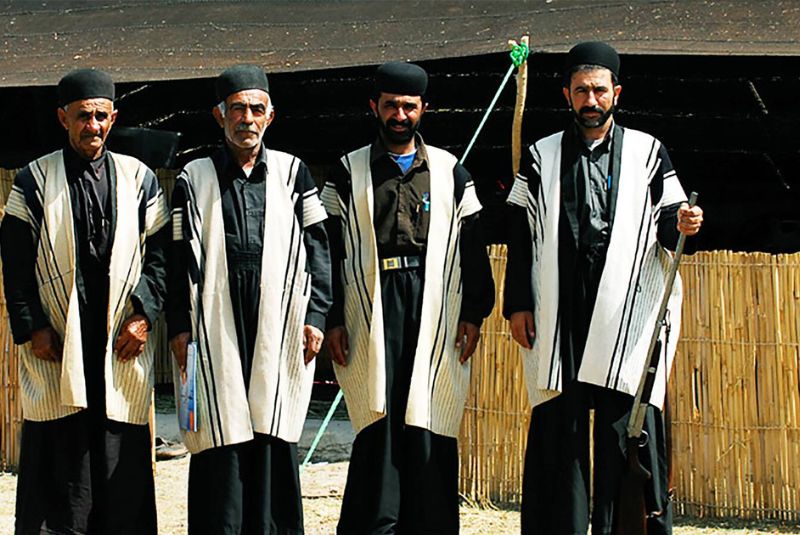
A distinguishing feature of traditional Iranian men's attire is the "Jubba" or "Aba." This is a long, robe-like outer garment that can be worn over the Qameh. The Jubba is often made from luxurious materials such as velvet, silk, or brocade. It is characterized by its wide sleeves, intricate embroidery, and rich colors, reflecting the wearer's social status and sense of style.
Men's headwear is also significant in Iranian traditional clothing. The " Kolah" or hat has been a popular accessory for centuries. It can vary in style, from the iconic "Pahlavi top hat" associated with the Qajar era to regional variations like the "Kolah-e Qandi" in southern Iran. The choice of headwear reflects not only fashion but also cultural identity and regional affiliation.
Colors play a vital role in Iranian men's traditional clothing. Earth tones such as beige, brown, and grey are commonly seen, representing a connection to nature and the surrounding environment. Vibrant colors like blue, green, and red are also utilized, especially in ceremonial and festive attire, symbolizing joy, prosperity, and celebration.
Iranian traditional clothing for men carries cultural significance and symbolism. Each garment and accessory is steeped in history and tradition, reflecting the wearer's social status, regional identity, and personal taste. The choice of materials, colors, and designs is a form of self-expression and a means of preserving cultural heritage.
Furthermore, traditional clothing serves as a reminder of Iran's rich history and cultural roots. By donning these garments, Iranian men not only embrace their heritage but also contribute to the preservation and promotion of their cultural identity. Traditional clothing for men in Iran is more than just attire—it is a reflection of tradition, pride, and a connection to the past.
Traditional Clothing for Women
Women's traditional clothing in Iran is a testament to the country's cultural diversity and the blending of ancient traditions with contemporary influences. Iranian women's attire encompasses a wide range of garments, each with its unique style, purpose, and regional variations.
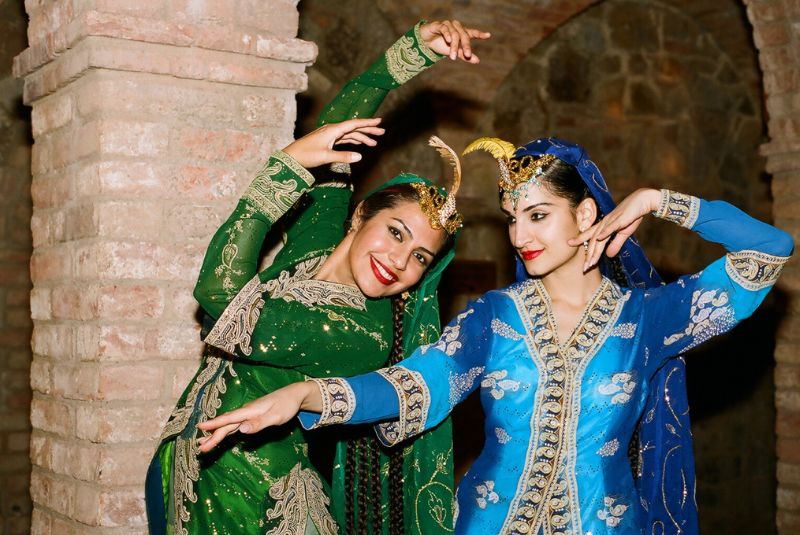
One of the most iconic garments worn by Iranian women is the "chador." The Chador is a full-length cloak that covers the entire body, leaving only the face exposed. It is typically made from lightweight fabric and comes in various colors. The Chador is associated with modesty and religious observance, particularly in more conservative regions of Iran.
Another traditional dress worn by Iranian women is the "Manteau." The Manteau is a knee-length coat-like garment that is often worn over a blouse or shirt and paired with pants. It can be made from a variety of fabrics, including cotton, linen, or silk. The Manteau is versatile and suitable for everyday wear, reflecting a blend of modern fashion and traditional elements.
Head coverings play a significant role in Iranian women's traditional clothing. The most common head covering is the "scarf" or "Roo-sari," which is worn to cover the hair and neck. Scarves come in a wide range of materials, colors, and styles, allowing women to express their individuality while adhering to cultural norms.
In addition to the scarf, various regional head coverings are prevalent across Iran. For example, the "Tarhah" is a traditional head covering worn in the city of Isfahan, characterized by its distinctive shape and intricate embroidery. The "Shahrband" is another type of head covering, often adorned with decorative pins and ribbons, and is popular in the southern regions of Iran.
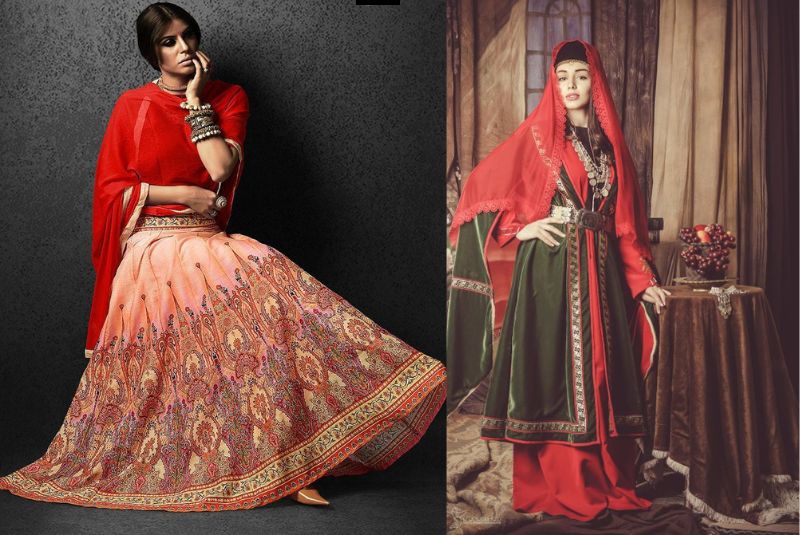
The regional variations in women's attire across Iran are influenced by factors such as geography, climate, and local customs. In more conservative and rural areas, women may opt for more modest and covering garments, whereas in urban centers, fashion trends and Western influences may shape women's choices.
For instance, in the northern regions of Iran, women often wear long, loose-fitting dresses known as "Roushans." These dresses are typically made from light fabrics and feature vibrant patterns and colors. In contrast, women in southern Iran may opt for "Bandari" attire, which includes colorful skirts, embroidered blouses, and intricate headscarves.
The diverse traditional clothing styles for women in Iran reflect not only regional variations but also the complex interplay of tradition, culture, and personal expression. These garments symbolize the values of modesty, elegance, and respect for cultural heritage. By embracing and preserving their traditional clothing, Iranian women contribute to the richness and diversity of Iranian culture.
Traditional Clothing of Iran in Different Regions
Traditional clothing of Iran showcases a remarkable regional diversity, with each area boasting its distinct style and characteristics. The clothing traditions in regions like Tehran, Shiraz, and Tabriz highlight the influence of climate, geography, and local customs on clothing styles.

- Tehran: As the capital city of Iran, Tehran exhibits a blend of traditional and modern clothing. Traditional clothing in Tehran often reflects urban fashion trends and is influenced by Western styles. Women may be seen wearing Manteaus paired with stylish scarves, while men opt for modern variations of the Qameh and Shalvar. However, traditional garments like the chador and men's traditional headwear are still prevalent, particularly in more conservative areas of the city.
- Shiraz: Located in the southern region of Iran, Shiraz is known for its hot and arid climate. Traditional clothing in Shiraz incorporates lightweight fabrics and vibrant colors to combat the heat. Women wear loose-fitting, colorful dresses with embroidered patterns, paired with headscarves adorned with pins and ribbons. Men often sport traditional head coverings, such as the Shahrband, along with Qameh made from breathable fabrics.
- Tabriz: Situated in the northwest of Iran, Tabriz experiences colder temperatures due to its proximity to the mountains. Traditional clothing in Tabriz reflects the need for warmth and protection against the elements. Women wear longer and heavier coats or mantles, known as "Kolahposh," often lined with fur or other insulating materials. Men may be seen in thick woolen coats and hats, providing adequate insulation during the colder seasons.
Climate, geography, and local customs significantly influence clothing styles in different regions of Iran. In regions with hot climates, lighter fabrics and loose-fitting garments are favored to promote airflow and comfort. On the other hand, regions with colder climates require heavier materials and more layers to provide warmth and insulation. The availability of local resources, such as particular fabrics or embroidery techniques, also contributes to the uniqueness of regional clothing styles.
Moreover, local customs and traditions influence the aesthetics and designs of traditional clothing. The motifs, colors, and patterns used in embroidery and textile weaving may differ based on cultural heritage and artistic traditions specific to each region. These variations add depth and complexity to the tapestry of the traditional clothing of Iran, highlighting the diverse cultural identities within the country.
The regional diversity in Iranian cultural clothing is a testament to the country's rich cultural heritage and the ability of clothing to adapt to local environments and customs. It is a reflection of the multifaceted nature of Iranian society and the dynamic interplay between tradition and innovation.
Traditional Clothing Accessories
Traditional Iranian attire is often complemented by a variety of accessories that add flair, cultural significance, and a touch of elegance to the overall ensemble. From exquisite jewelry to beautifully crafted belts, scarves, and footwear, these accessories play a vital role in completing the traditional Iranian look.
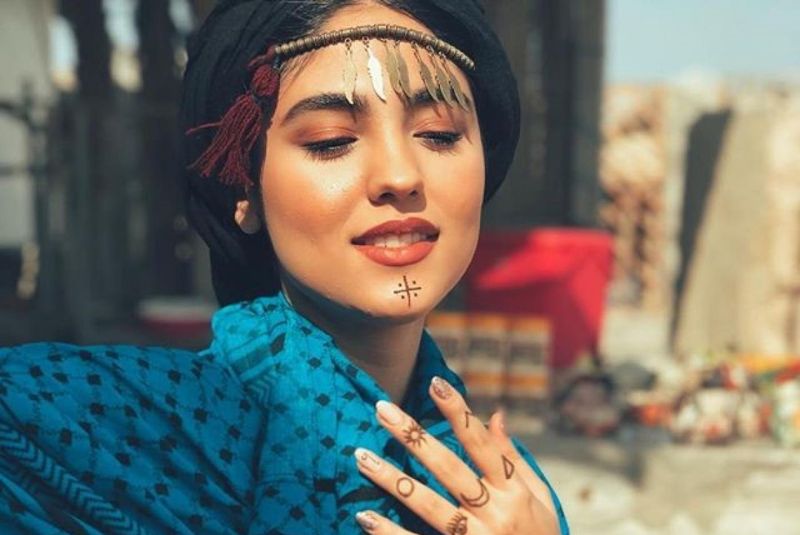
- Jewelry: Jewelry holds a special place in Iranian culture and is an integral part of traditional attire. Women often adorn themselves with intricately designed pieces, such as necklaces, bracelets, earrings, and rings. Traditional Iranian jewelry is known for its delicate craftsmanship, incorporating motifs inspired by nature, mythology, and Persian poetry. Materials such as gold, silver, turquoise, and precious gemstones are commonly used, symbolizing wealth, beauty, and spirituality.
- Belts: Belts serve both functional and decorative purposes in traditional Iranian clothing. They are worn to cinch the waist and provide a flattering silhouette. Traditional Iranian belts, known as "Kamarband," are often made from luxurious fabrics, such as silk or brocade, and feature intricate embroidery, beading, or metalwork. These belts add a touch of sophistication and accentuate the waistline, enhancing the overall look of traditional attire.
- Scarves: Scarves, or "Rousari," are an essential accessory for Iranian women. They are not only worn as a head covering but also as a fashion statement. Scarves come in a variety of fabrics, colors, and styles, allowing women to express their personal tastes while adhering to cultural norms. Traditional Iranian scarves are often beautifully embellished with intricate patterns or embroidery, adding a touch of elegance to the overall ensemble.
- Footwear: Traditional Iranian footwear includes a range of styles, each designed to complement specific garments and occasions. One such style is the "Giveh," a handmade shoe made from natural materials like cotton or leather. Givehs are known for their comfort, durability, and unique woven patterns. For more formal occasions, women may opt for "Kolah-pich" or "Papouch," which are intricately embroidered slippers or sandals. Men often wear "Charoq" or leather shoes, which are durable and suitable for various environments.
These traditional accessories hold significant cultural and symbolic meanings. They reflect the craftsmanship, artistic heritage, and attention to detail that has been passed down through generations. The jewelry, belts, scarves, and footwear worn with Iranian traditional clothing not only enhance the aesthetic appeal but also serve as a testament to the cultural pride and identity of the wearer.
Furthermore, these accessories often hold personal and sentimental value, representing family heirlooms or gifts exchanged during special occasions. They carry stories, traditions, and memories, connecting individuals to their roots and preserving cultural heritage.
The artistry and craftsmanship behind these accessories are celebrated and appreciated, not only within Iran but also internationally. The intricate designs, meticulous handiwork, and the use of precious materials highlight the skill and creativity of Iranian artisans, contributing to the reputation of Iranian traditional accessories as pieces of wearable art.
Festive Attire and Ceremonial Dress
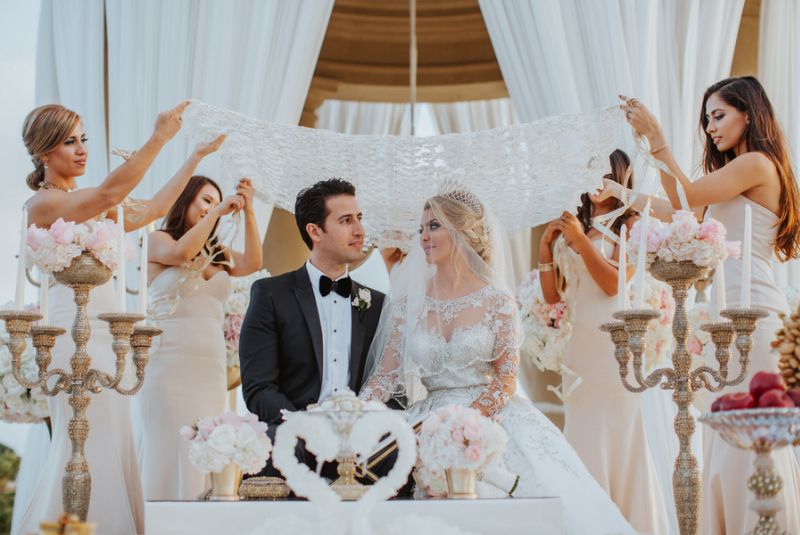
Traditional Iranian clothing holds a special place in festive occasions and ceremonial events, such as weddings, festivals, and religious gatherings. During these momentous celebrations, the attire becomes a vivid reflection of cultural heritage, social status, and the joyous spirit of the occasion.
- Weddings: Iranian weddings are a grand celebration filled with traditions and symbolism, and the attire worn by the bride, groom, and guests reflects the significance of the event. The bride typically wears a stunning wedding dress, often a combination of traditional and modern elements. The dress may feature intricate embroidery, embellishments, and a flowing silhouette. Brides also adorn themselves with exquisite jewelry, such as elaborate necklaces, earrings, and headdresses. The groom may opt for a traditional suit, often in a darker color, symbolizing masculinity and formality. Guests at Iranian weddings also dress in their finest attire, incorporating vibrant colors and traditional patterns to join in the festive atmosphere.
- Festivals: Festivals in Iran are marked by a burst of colors, lively music, and joyous celebrations. Traditional clothing worn during festivals reflects the vibrancy and exuberance of these occasions. Women may wear brightly colored dresses with intricate embroidery and patterns, often made from lightweight fabrics for comfort during outdoor festivities. Men also embrace vibrant attire, pairing colorful shirts with traditional pants and completing the look with traditional headwear. The combination of vivid colors, intricate details, and flowing fabrics creates a visual spectacle, symbolizing joy, unity, and cultural pride.
- Religious Events: Religion holds a central place in Iranian culture, and religious events are occasions where traditional clothing takes on added significance. During religious ceremonies, both men and women often opt for modest attire, adhering to religious customs and guidelines. Women may wear chadors, loose-fitting dresses, or long coats paired with scarves, while men may choose traditional tunics or robes. The emphasis is on modesty, simplicity, and respect for religious traditions. Colors may be more subdued, and the focus is on the spiritual significance of the event rather than elaborate ornamentation.
Vibrant colors, intricate embroidery, and patterns play a pivotal role in festive attire and ceremonial dress in Iran. These elements contribute to the visual splendor of the occasion and reflect the cultural aesthetics and artistic traditions of the country. The choice of colors often holds symbolic meaning, with red symbolizing joy and celebration, green representing fertility and renewal, and gold signifying prosperity and abundance. Embroidery and patterns showcase the craftsmanship and skill of Iranian artisans, adding depth, texture, and a touch of sophistication to the attire.
Modern Adaptations and Contemporary Fashion
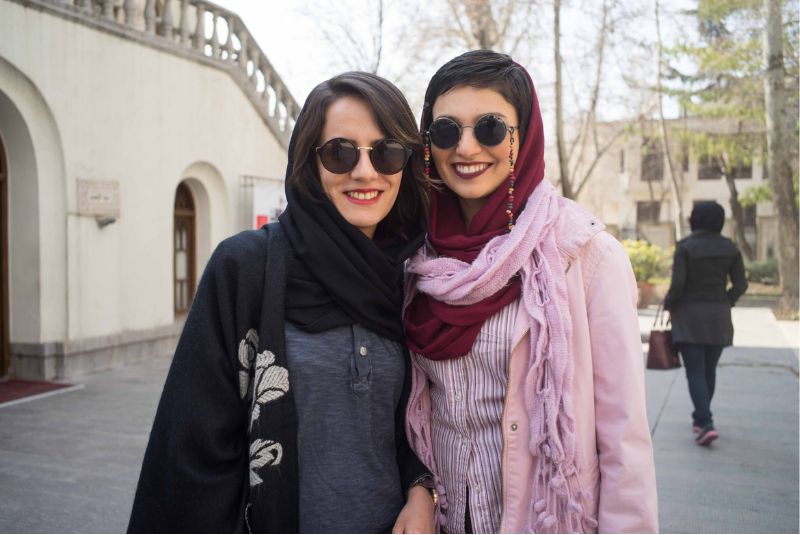
The influence of Western fashion has made a significant impact on traditional Iranian clothing, leading to modern adaptations and the emergence of contemporary trends. These transformations have reshaped Iranian fashion, blending elements of tradition and innovation while preserving cultural identity.
The interaction with Western fashion began in the early 20th century when Iran experienced a period of modernization and increased cultural exchange. Western clothing styles, such as tailored suits and dresses, began to influence Iranian fashion, particularly in urban areas. This influence continued to grow over the years, with Iranian designers incorporating Western silhouettes, fabrics, and techniques into traditional clothing.
Today, contemporary Iranian fashion reflects a fusion of traditional elements and global trends. Designers experiment with cuts, patterns, and materials to create garments that appeal to both local and international audiences. Traditional motifs and embroidery techniques are incorporated into modern designs, creating a unique blend of old and new.
Efforts to preserve and revive traditional clothing in modern times have also gained momentum. Organizations, designers, and artisans are actively working to promote traditional Iranian attire and ensure its continued relevance in the face of globalization. This includes initiatives to document traditional designs, techniques, and patterns, as well as supporting local artisans who specialize in traditional craftsmanship.
In recent years, there has been a growing demand for sustainable and ethically produced fashion worldwide. This trend has also influenced the fashion industry in Iran, leading to a renewed focus on traditional textiles and eco-friendly practices. Designers are exploring organic fabrics, natural dyes, and traditional weaving techniques, aligning contemporary fashion with sustainable values.
Bottom Line
The traditional clothing of Iran encompasses a rich and diverse heritage that reflects the country's historical, cultural, and regional identities. From the ancient civilizations to the dynasties that have shaped the nation, Iranian attire has evolved over time, embracing influences from various cultures while maintaining its distinctive character.
In the realm of traditional clothing, Iran stands as a testament to the enduring beauty, diversity, and cultural significance of attire. Let us embrace and honor the legacy of traditional clothing in Iran, not only for its aesthetic appeal but also for the profound connection it offers to the essence of Iranian culture.


Comment
Leave a Comment